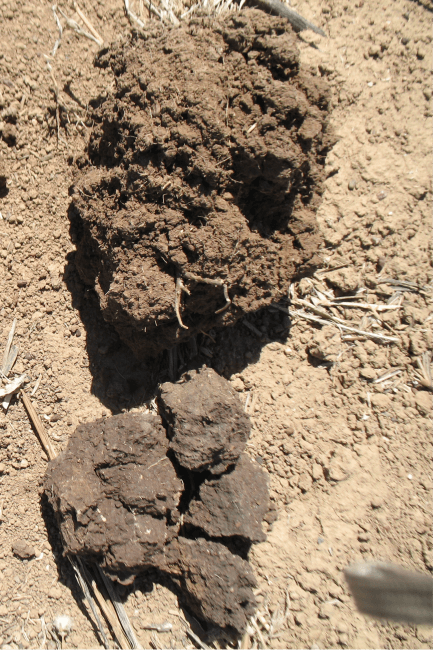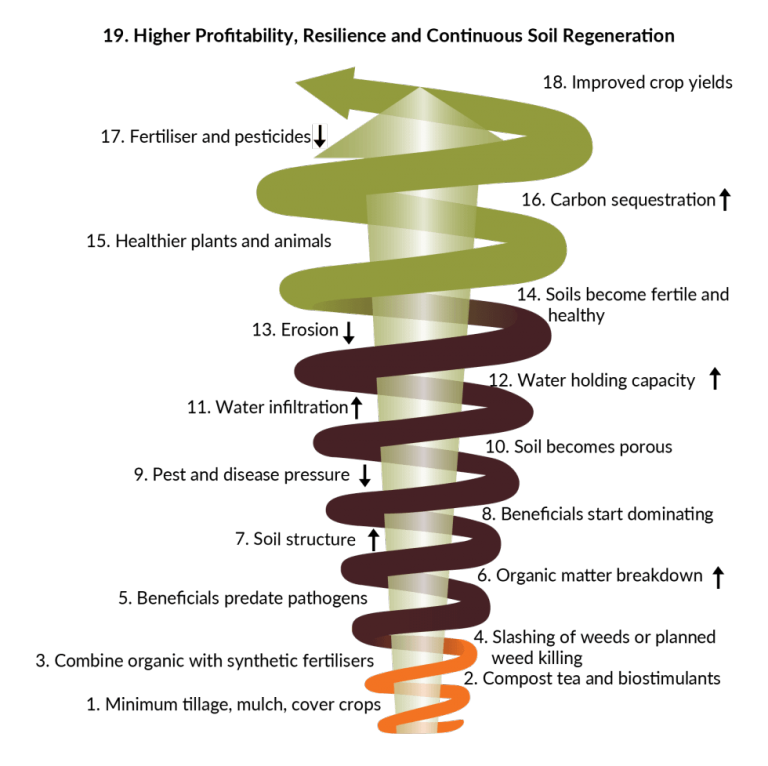- +27 (0)21 848 9434
- marketing@ecosoil.co.za
- Mon - Fri: 8:00 - 16:30
The process of soil degradation
Bacteria have a 5:1 carbon to nitrogen ratio and contain about 17% nitrogen in their bodies. Soil tillage and nitrogen applications stimulate bacteria to multiply. In the absence of applied carbon, they have no choice but to target humus. When soil carbon is lost, we also lose the storage space for nitrogen and other minerals.
The use of unbuffered salt fertilizers dehydrates and kills many beneficial bacteria, tillage slices and dices mycorrhiza and other fungi and oxidizes humus. However, the single most destructive component of modern agriculture, in terms of soil life, has been herbicides, fungicides and pesticides.

When beneficial soil organisms are lost, the glues and gums which microbes have produced that structure soil into aggregates degrade, and the soil becomes compacted. Mostly micro pores remain. Without plant residues on the soil surface, a soil crust forms. Air cannot freely enter the soil and nitrogen fixing bacteria cannot function without the presence of aggregates and liquid carbon. Root growth diminishes as a result.
Inorganic Nitrogen (N):
In an effort to stimulate growth, more fertilisers are applied, further reducing microbial diversity and soil function. In the absence of diverse beneficial microorganisms, disease causing organisms proliferate, setting in motion the continuous use of pesticides.
When inorganic fertilisers are applied, they dissolve in the soil solution in an ionic form and move into the plant as the water is taken up by the roots. Inorganic nitrogen (N) can either be taken up in the ammonium (NH4+) or nitrate (NO3–) form. This is mostly a passive process directed by osmosis meaning that N flows from a higher concentration in the soil solution to a lower concentration inside the root. Being a passive process, the plant has no “say” over this, causing some unintended consequences.
This can result in the production of incomplete or “funny” protein. This becomes a problem in cattle if it turns up as high levels of blood urea nitrogen (BUN) or milk urea nitrogen (MUN). Nitrates cause metabolic disorders including infertility, mastitis, laminitis and liver dysfunction. Milk often has nitrate levels above safe drinking standard. The bitter taste in lettuce, carrots and other produce are typical of high nitrate levels. There is a strong link between nitrate and cancer.

Another unintended consequence of the use of inorganic fertilisers is that they typically only contain macro nutrients (N,P,K) and no micro nutrients. This leads to a mineral imbalance in plants which causes thin cell walls, plant stress and disease. Crops harvested from these plants have low nutrient density and have a poor shelf life.
In most agricultural soils as little as 10 to 40% of applied N is taken up by plants, the remaining 60 to 90% is lost through a combination of volatilisation, denitrification and leaching. This is exemplified in China where a massive 37-fold increase in N fertilizer rates from 1961 to 2009 has achieved only a 3.4-fold increase in yield.
In the oldest continuously cropped experimental fields in the United States it was found that the fields that received the highest rates of nitrogen fertiliser had ended up with less soil carbon and, ironically less nitrogen than the other fields. Nitrogen fertiliser stimulates bacteria that break down soil carbon. Carbon locks up N in the soil. If carbon is decomposing, then the soil will also be losing nitrogen. They decompose together.
All ionic nutrients held in the soil solution are prone to leaching. In clay soils ammonium (NH4+) can bind to the negatively charged clay particles but nitrate (NO3–) cannot and is more easily lost through leaching. In sandy soils NH4+ is also prone to leaching. Humus can prevent the leaching of both ionic forms.
As soils dry out, much nitrogen is lost through volatilisation and denitrification. Further, it has been shown that up to 80kgN/ha can be volatilised from bare summer fallows due to denitrification. If green plants are present, this N can be taken up and recycled, preventing irretrievable loss. Compacted, anaerobic (low oxygen) soils become easily waterlogged and a lot of N is lost as nitrous oxide which is a greenhouse gas with almost 300 times the global-warming potential of carbon dioxide. Some nitrates will also be converted by denitrifying bacteria to nitrogen gas lost into the atmosphere.
Inorganic Phosphorus (P)
The application of large quantities of water-soluble P, such as found in MAP, DAP or superphosphate, inhibits the production of strigolactone, an important plant hormone. Strigolactone increases root growth, root hair development and colonisation by mycorrhizal fungi, enabling plants to better access soil P. The long-term consequences of the inhibition of strigolactone include destabilisation of soil aggregates, increased soil compaction and mineral-deficient plants and animals.
In addition to having adverse effects on soil structure and the nutrient density of food, the application of inorganic phosphorus is highly inefficient. Only 10-15% of fertiliser P is taken up by crops. The rest react with calcium, aluminium, manganese or iron and are not plant available in the absence of microbial activity.

In one study it was found that an individual today would need to consume twice as much meat, three times as much fruit and four to five times as many vegetables to obtain the same amount of minerals and trace elements available in those same foods in 1940.
Furthermore, the shelf life of most produce is poor and they look pretty sad after two weeks at room temperature.
Food produced from depleted soils does not contain the essential trace minerals required for the effective functioning of our immune systems. The cancer rate, for example, has increased from approximately 1 in 100, fifty years ago, to almost 1 in 2 today.
These are merely symptoms of a dysfunctional soil food web system. Vitamin and mineral deficiencies in food indicate that the symbiotic relationship between plants and soil microbes, whereby minerals are exchanged for liquid carbon from the plant, has been disrupted. As a result of soil function deterioration, input costs rise, crop quantity and quality suffer, putting profit margins under pressure – downward spiral of soil degradation.
Downward spiral of soil degradation

Practical implications
It is important to know the precise quantity of minerals that are removed by harvesting a crop. By comparing this to what is applied to the crop, losses due to leaching, volatilisation and denitrification can be determined. Most of these losses could have been prevented if an adequate soil food web was functioning, building topsoil deep down, locking down carbon in the soil, thereby reducing the pressure on global warming. At the same time, acting like a biofilter, trapping all nutrients, saving it from being leached or volatilised.
The use of high doses of inorganic fertiliser is not conducive to building a healthy soil food web and it is therefore quite unnecessary. Ecosoil has a proven track record in this regard. While restoring soil health, it is possible to cut fertiliser use and still get better production and quality.
In degraded agricultural soils there is no functional microbial bridge and plants can only utilise minerals in the ionic form. This is a passive process of nutrient uptake and the plant has no “say” over this.
In microbially active soils, nutrients can be utilised by plants in both the organic (amino acids) and inorganic (ions) form. This is a plant mediated or active pathway of nutrient acquisition and results in a more balanced nutrient uptake which results in healthy plants unlike the passive form of nutrient uptake associated with just using inorganic fertilisers.
Soil organisms influence every aspect of decomposition and nutrient availability. By applying Ecosoil Compost Tea, a huge diversity of soil building microbes will be inoculated, thereby greatly enhancing soil function. Combining this with covering the soil at all times, preferably with year long green cover or, at the very least, with crop residues, will give the micro-organisms enough food to build soil humus levels.

Dry land wheat – Control

Dry land wheat – Ecosoil’s Compost Tea
This will increase the photosynthetic capacity of the crop, thereby increasing the amount of liquid carbon released. This in turn will increase microbial efficiency, thereby increasing the formation of soil aggregates and improving porosity. This is crucial for nitrogen fixation to occur. Some of the nitrogen and other minerals will be used by micro-organisms, some by the crop and some will be used in the formation of stable soil carbon, called humus.
Humus will greatly increase the nutrient holding capacity and the water holding capacity of the soil, making it more fertile. This in turn will increase production, health and profitability – upward spiral of soil regeneration.
Upward spiral of soil regeneration

